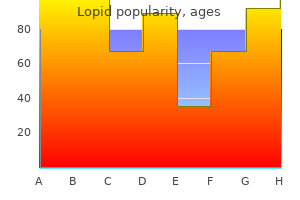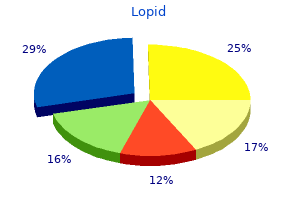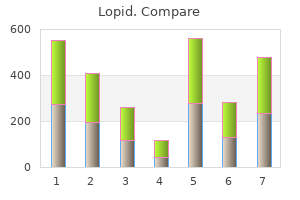Lopid
"Purchase lopid on line amex, medications related to the female reproductive system".
By: X. Ballock, M.B. B.CH. B.A.O., M.B.B.Ch., Ph.D.
Professor, Baylor College of Medicine
The clinical use of clonidine in abrupt withdrawal from methadone: effects on blood pressure and specific signs and symptoms symptoms nicotine withdrawal generic 300mg lopid with mastercard. Length of treatment with anxiolytic sedatives and response to their sudden withdrawal treatment 30th october cheap lopid 300 mg with amex. Amphetamine-induced dopamine release in human ventral striatum correlates with euphoria symptoms for diabetes generic lopid 300 mg otc. High blood alcohol levels in women: the role of decreased gastric alcohol dehydrogenase activity and first-pass metabolism medicine woman discount 300mg lopid overnight delivery. Comparison of haloperidol and chlorpromazine in the treatment of phencyclidine psychosis. Clinical efficacy of gabapentin versus tiagabine for reducing cocaine use among cocaine dependent methadone-treated patients. Motor dysfunction as a permanent complication of methanol intoxication: presentation of a case with a beneficial response to levodopa treatment. Cannabis receptor haplotype associated with fewer cannabis dependence symptoms in adolescents. Methanol outbreak in Norway: epidemiology, clinical features and prognostic signs. Caffeine selfadministration, withdrawal, and adverse effects among coffee drinkers. Effects in former morphine addicts and development of tolerance during chronic intoxication. Oral topiramate for treatment of alcohol dependence: a randomized controlled trial. A preliminary randomized double-blind, placebo-controlled study of the safety and efficacy of ondansetron in the treatment of cocaine dependence. A controlled trial of sustained-release bupropion, a nicotine patch, or both for smoking cessation. Comparing and combining naltrexone and acamprosate in relapse prevention of alcoholism: a double-blind, placebo-controlled study. Sudden deaths in adolescents resulting from inhalation of typewriter correction fluid. Clonazepam treatment of lysergic acid diethylamide-induced hallucinogen persisting perception disorder with anxiety features. Acute phencyclidine intoxication: clinical patterns, complications, and treatment. Double-blind controlled trial comparing carbamazepine to oxazepam treatment of alcohol withdrawal. Pathological intoxication, alcoholic hallucinosis, and other reactions to alcohol: a clinical study. Tracking difficulties and paranoid ideation during hashish and alcohol intoxication. Naltrexone versus acamprosate in the treatment of alcohol dependence: a multicentre, randomized, double-blind, placebo-controlled trial. Intracranial hemorrhage associated with cocaine abuse: a prospective autopsy study. Separate mechanisms for behavioral, cardiovascular, and hormonal responses to dextroamphetamine in man. Lorazepam and meprobamate dose effects in humans: behavioral effects and abuse liability. Phenomenologic comparison of the idiopathic psychosis of schizophrenia and drug-induced cocaine and phencyclidine psychoses: a retrospective study. Carbamazepine treatment in patients discontinuing long-term benzodiazepine therapy: effects on withdrawal severity and outcome.
Spotted Touch-Me-Not (Jewelweed). Lopid.
- Are there any interactions with medications?
- Dosing considerations for Jewelweed.
- How does Jewelweed work?
- What is Jewelweed?
- Mild digestive disorders, rash from poison ivy, and other conditions.
Source: http://www.rxlist.com/script/main/art.asp?articlekey=96535

Food contaminated by botulism toxin may have no detectable change in appearance or taste symptoms throat cancer discount lopid amex. Eight immunologically distinct toxins have been described: A medicine 44334 buy cheap lopid online, B medicine hat college discount 300 mg lopid with visa, C and C medications mitral valve prolapse 300 mg lopid otc, D, E, F, and G. Toxins A and B are the most potent; even small tastes of food contaminated with these toxins have resulted in fullblown disease. In the United States, toxin A is found predominantly west of the Mississippi, whereas toxin B is found in the eastern states. Toxin E is found in the Great Lakes region and in Alaska, where one of the highest rates of botulism worldwide is seen. In food-borne botulism, ingested preformed toxin is absorbed in the stomach and upper small intestine. Toxins are reduced in size by proteolytic enzymes, but their activity remains unchanged. Botulism toxin has potential as a weapon of bioterrorism, both from ingestion and by inhalation. Clinical findings would be identical, but possible features would include a large outbreak with common environmental exposure, an unusual toxin type, or multiple simultaneous outbreaks. Many cases of wound botulism have occurred in teenagers, children, and injection drug users. In recent years, there has been a dramatic increase in the number of cases of wound botulism linked to the subcutaneous injection of impure "black tar" heroin imported from Mexico, perhaps the result of contamination of the drug during the "cutting" process with adulterants such as dirt. Adult Infectious Botulism-While most cases of adult botulism are the result of ingested preformed toxin, there have been cases of botulism in patients with documented C. Symptoms and Signs-An initial pentad of signs and symptoms has been described in botulism, consisting of nausea and vomiting, dysphagia, diplopia, dilated and fixed pupils, and an extremely dry mouth unrelieved by drinking fluids. Abnormalities of cranial nerve motor functions are followed by descending symmetric paralysis or weakness. Respiratory muscle weakness may be subtle or may progress rapidly to respiratory failure. Patients may develop autonomic nervous system manifestations, including constipation from paralytic ileus, gastric dilation, urinary retention, and orthostatic hypotension. Notably absent in patients with botulism are sensory disturbances, changes in sensorium, and fever. Deep tendon reflexes may be intact, diminished, or absent, but pathologic reflexes cannot be demonstrated. In addition, the heart rate may be normal or slow unless secondary infection is present. Laboratory Findings-The diagnosis of botulism is confirmed by isolating botulism toxin through a mouse neutralization bioassay. Toxin may be identified in samples of serum, stool, vomitus, gastric aspirate, and suspected foods. Because the toxin may enter the bloodstream through the eye or a small break in the skin, only experienced personnel, preferably immunized with botulinum toxoid, should handle specimens. Electromyography may be useful in establishing a diagnosis of botulism but can be nonspecific and nondiagnostic even in severe cases. Low-amplitude and short-duration motor unit action potentials, small M-wave amplitudes, and posttetanic fasciculation may be seen. Antitoxin will not neutralize toxin already bound to neuromuscular junctions, and although it can slow disease progression, it has no effect on established neurologic impairment. Two vials of the appropriate antitoxin should be given, one intramuscularly and one intravenously. Because of the risk of adverse reactions, prophylactic antitoxin is not recommended for those who have been exposed to botulism toxin but have no symptoms. If ingestion is recognized early, patients may undergo gastric lavage or induced vomiting in an attempt to eliminate the toxin prior to absorption. Single-fiber electromyography may be a more useful and sensitive method for the rapid diagnosis of botulism intoxication, particularly when signs of general muscular weakness are absent.

In patients presenting with massive fluid overload symptoms xanax treats order generic lopid online, continuous hemofiltration offers the best-tolerated treatment because the ultrafiltrate is isosmotic medications such as seasonale are designed to order lopid 300 mg fast delivery. A reasonable combination of treatments would employ several days of continuous hemofiltration to achieve normovolemia xanthine medications order lopid 300mg without a prescription, followed by intermittent hemodialysis to provide maintenance therapy medicine 4211 v purchase lopid without prescription. Toxic serum levels of calcium, magnesium, or phosphate are also most rapidly corrected with machine-driven hemodialysis. Once normal levels are achieved, any of the renal replacement therapies can maintain homeostasis if nutritional intake is limited and magnesium-containing phosphate binders are avoided. Renal replacement therapies using dialysate (ie, hemodialysis, peritoneal dialysis, or continuous hemodialysis) may contain calcium concentrations of 3. Therefore, successful and rapid treatment of hypercalcemia requires lower dialysate calcium concentrations of 2. Severe hypophosphatemia may complicate all renal replacement therapies, especially in patients being maintained on intravenous hyperalimentation devoid of phosphate. Lactic acid may be produced at rates of up to 50 mmol/h and usually is associated with severe hemodynamic instability. Although daily hemodialysis can provide adequate replacement of lost bicarbonate, the patient may be left with rapidly worsening acidosis during the interdialytic period. Continuous hemofiltration can provide continuous correction of acidosis and may be best for managing the fluid overload often associated with shock and its treatment. Replacement solutions containing 150 mmol/L bicarbonate can provide as much as 100 mmol/h of continuous buffer replacement, but required calcium replacement must be administered in a separate solution. Peritoneal dialysis, with exchanges at 2 L/h, can provide approximately 25 mmol buffer per hour. Dialytic solutions containing lactate should be avoided because conversion to bicarbonate may be slowed in patients with circulatory impairment. Uremia Although urea is not universally accepted as a uremic toxin, its levels are used most commonly to judge the degree of uremic toxicity. There is good or better evidence to suggest that proper protein-calorie nutrition is also beneficial. Thus it is inappropriate to withhold adequate nutrition in order to avoid the associated increase in nitrogen and fluid intake. Nonetheless, if rapid return of renal function is anticipated (eg, in the presence of prerenal azotemia or obstructive uropathy), levels of 150 mg/dL (54 mmol/L) or more may be tolerated for a limited period. Specific indications for dialytic therapy for complications of uremia include uremic encephalopathy, pericarditis, and uremic platelet dysfunction. Slowed mentation, somnolence, and convulsions are part of the uremic syndrome and are usually associated with other neuromuscular manifestations, including asterixis, myoclonus, and muscle twitching. In general, these symptoms respond within several days after the start of dialytic therapy. Despite the existence of massive pericardial effusions, patients with uremic pericarditis may present with hypertension and pulmonary congestion. Severe uremic acidosis is encountered most often as a presenting abnormality of unattended chronic renal failure. Under these conditions, hemodialysis can provide the most rapid correction of acidosis, but aggressive hemodialysis may precipitate a dysequilibrium syndrome. Initial rapid fluid removal with hemodialysis may be well tolerated, but as volume removal proceeds, intravascular pressures may become inadequate to maintain intracardiac filling, and severe hypotension may result. Thus normovolemia should be achieved with gentle fluid removal and anticipation of rapid declines in blood pressure.

Treat with oxygen medications pain pills lopid 300mg without a prescription, diuretics treatment viral pneumonia order 300mg lopid free shipping, and medications you cannot eat grapefruit with buy line lopid, rarely medications quinapril lopid 300 mg, phlebotomy (save units for reinfusion if necessary). Transfusing with more than one blood volume or red blood cells with dilute platelets and coagulation factors. May occur in patients with preexisting renal insufficiency and hyperkalemia or in neonates. Use of fresh blood or washed red cells decreases potassium load for these patients. After massive transfusion of refrigerated blood, hypothermia may cause cardiac arrhythmias. Refrigerated blood may accelerate hemolysis in patients with cold agglutinin disease. Mechanisms and clinical significance unclear for immunosuppression that follows transfusion; enhances results following renal transplantation; possible deleterious effect on outcome after colorectal cancer surgery; possible increased susceptibility to bacterial infections. Prevent by irradiating all blood components with 2500 cGy for immunocompromised recipients or when donor is first-degree relative. Multiple transfusions in the absence of blood loss lead to excess accumulation of body iron with cirrhosis, heart failure, and endocrine organ failure. Prevent by decreasing total amount of red cells given, using alternatives to red cells whenever possible, using neocytes, and modifying diet to decrease iron absorption. Iron chelation indicated for patients with chronic transfusion dependence if prognosis is otherwise good. Acute severe thrombocytopenia about 1 week after transfusion due to alloantibodies to donor platelet antigen (usually P1A1). Self-limited, but treatment with steroids, high-dose IgG, plasmapheresis, or exchange transfusion recommended to prevent central nervous system hemorrhage. Increased supply of complement may accelerate hemolysis in paroxysmal nocturnal hemoglobinuria or make angioedema worse in patient with C1 esterase inhibitor deficiency. Preoperative autologous red blood cell donations are desirable whenever elective surgery likely to require red blood cell transfusion is planned and the patient is medically suitable for donation. Epoetin alfa (erythropoietin) use may enhance collection in patients with anemia or those likely to require large amounts of red blood cell transfusions. Although autologous donation may decrease the use of allogeneic blood from an ever decreasing donor pool, thus reserving it for emergencies, about half the autologous blood collected is discarded, which is both wasteful and costly. Preoperative autologous donation may increase the risk of ischemic events, thereby outweighing the potential decrease in infectious risks, particularly in patients undergoing cardiovascular bypass surgery. In addition, collection of autologous blood preoperatively increases the risk of postoperative anemia and actually may increase the need for perioperative transfusion. Therefore, criteria for transfusion of autologous units should be the same as those for transfusion of homologous red blood cells to avoid these unnecessary potential complications. Acute normovolemic hemodilution may be suitable for patients undergoing surgical procedures with a significant risk of intraoperative bleeding (>20% of blood volume) who have baseline hemoglobin levels greater than 10 g/dL and who do not have severe ischemic heart disease or critical aortic stenosis. Phlebotomy with volume replacement by crystalloid is performed immediately after anesthetic induction. Blood lost intraoperatively results in loss of fewer red blood cells because of the lowered hematocrit, and subsequent reinfusion of the phlebotomized blood can restore oxygencarrying capacity, if necessary. Perioperative allogeneic transfusion requirements following acute normovolemic hemodilution or preoperative autologous donation appear to be about the same when compared directly in certain types of surgery, but there are some advantages favoring hemodilution. Intraoperative blood salvage may be indicated for patients undergoing procedures with substantial blood loss or when transfusion is impossible (eg, patients who refuse blood transfusions and patients with rare blood groups or multiple red blood cell alloantibodies). Reinfusion of blood salvaged from the surgical field can reduce the requirement for standard homologous and autologous blood transfusions.
Buy lopid 300 mg on-line. Clinical progression of multiple sclerosis | Nervous system diseases | NCLEX-RN | Khan Academy.

